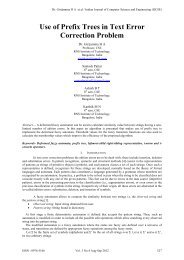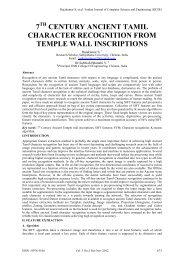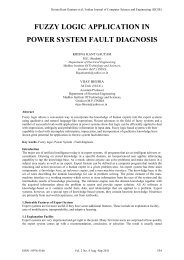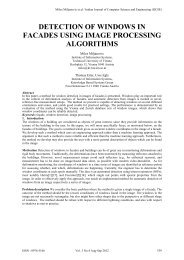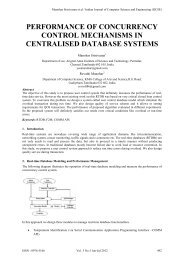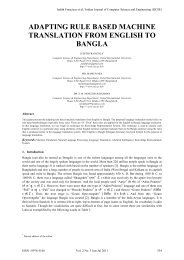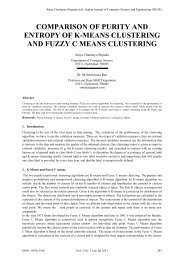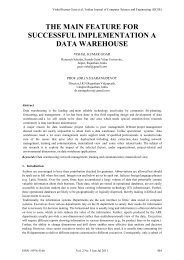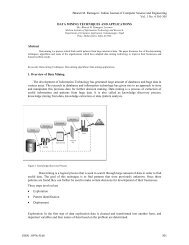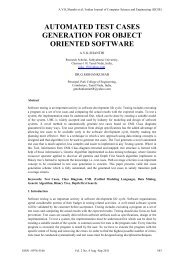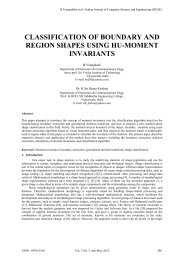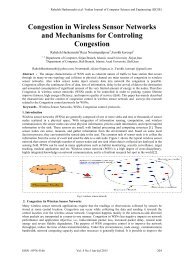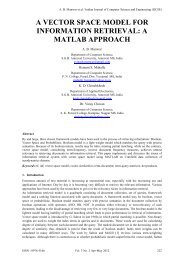D. Lalitha et al / <strong>Indian</strong> <strong>Journal</strong> <strong>of</strong> <strong>Computer</strong> Science and Engineering (IJCSE)t 1 (p 1 )p 5p 4p S 1t 4 (p 6 )t 2Sp 3p 2t 7 (p 8 )t p 6 3p 9p 8t 6t 5p 7t 9t 8t 11 p 11t 10 p 10D σ(t 2 ) = { D↑ D },S = DD σ(t 5 ) = { tm D→ S 1 , bm D→S 2 , D→D},σ(t 6 )= σ(t 5 )σ(t 8 ) = { tm D← S 4 , bm D←S 3 , D←D},σ(t 9 ) = σ(t 9 )σ(t 10 ) = { D↑d 4 }σ(t 11 ) = { D↓d 2 }fig 9fig 8The firing sequence t 2 t 3 t 4 t 5 t 6 t 7 t 8 t 9 t 10 t 11 generates the Kolam pattern in fig 10. To start with t 2 and t 3 are bothenabled. If t 2 is fired then the inhibitor input p 4 <strong>of</strong> t 6 makes sure that the sequence t 4 t 5 is also fired the samenumber <strong>of</strong> times. Similarly the inhibitor input p 5 <strong>of</strong> t 9 makes sure that the sequence t 7 t 8 is also fired the samenumber <strong>of</strong> times. The Kolam <strong>patterns</strong> generated are <strong>of</strong> size (2n + 4) x (2n +3)/ n ≥ 0, where n is the number <strong>of</strong>times t 2 is fired. This <strong>kolam</strong> is context-sensitive [5].Fig 10: Kambi <strong>kolam</strong>4. Comparative ResultsIn this section we recall the definitions <strong>of</strong> Array rewriting Grammar [6], compare KATPNS and KATPNSwith inhibitor arcs with some <strong>of</strong> the Kolam array grammars.Definition 6: G = ( V, I, , S ) is an array rewriting grammar(AG), where V = V 1 V 2 , V 1 a finite set <strong>of</strong>nonterminals, V 2 a finite set <strong>of</strong> intermediates, I a finite set <strong>of</strong> terminals, P = P 1 P 2 P 3 , P 1 is the finite set <strong>of</strong>nonterminal rules, P 2 is the finite set <strong>of</strong> intermediate rules, P 3 is the finite set <strong>of</strong> terminal rules. S V 1 is the startsymbol. P 1 is a finite set <strong>of</strong> ordered pairs (u, v), u and v in (V 1 V 2 ) + or u and v in (V 1 V 2 ) +.P 1 is context-sensitive if there is a (u,v) in P 1 such that u = u 1 S 1 v 1 and v = u 1 α v 1 where S 1 V 1 , u 1 , α, v 1 areall in (V 1 V 2 ) + or all in (V 1 V 2 ) +. P 1 is context-free if every (u,v) in P 1 is such that uV 1 and v in (V 1 V 2 ) + or (V 1 V 2 ) +. P 1 is regular if u V 1 and v <strong>of</strong> the form U V, U inV 1 and V in V 2 or U in V 2 and V inV 1 .P 2 is a set <strong>of</strong> ordered pairs (u,v), u and v in (V 2 {x 1 ,…,x p }) + or u and v in (V 2 {x 1 ,…,x p }) + ;x 1 ,…,x p in I ++ have same number <strong>of</strong> rows in the first case and same number <strong>of</strong> columns in the second case. P 2 iscalled CS, CF or R as the intermediate matrix languages generated are CS, CF or R.P 3 is a finite set <strong>of</strong> terminal rules are ordered pairs (u,v), u in (V 1 V 2 ) and v in I ++ .An Array Grammar is called (CS:CS)AG if the nonterminal rules are CS and at least one intermediate languageis CS. An Array Grammar is called (CS:CF)AG if the nonterminal rules are CS and none <strong>of</strong> the intermediateISSN : 0976-5166 Vol. 3 No. 1 Feb-Mar 2012 73
D. Lalitha et al / <strong>Indian</strong> <strong>Journal</strong> <strong>of</strong> <strong>Computer</strong> Science and Engineering (IJCSE)language is CS. An Array Grammar is called (CS:R)AG if the nonterminal rules are CS and all the intermediatelanguages are regular. Similarly all the other six families (CF:CS)AG, (CF:CF)AG, (CF:R)AG, (R:CS)AG,(R:CF)AG and (R:R)AG are defined. (X:Y)AL refers to the language generated by the (X:Y)AG, where X, Y{ R, CF,CS}.Theorem 4.1. Any Regular Matrix <strong>kolam</strong> can be generated by KATPNS.Pro<strong>of</strong>. If the pattern is generated by a regular matrix grammar then it can be generated by (R:R)AG. Any regulararray grammar can be generated by a Array Token Petri Net Structure (ATPNS) without inhibitor arcs [10]. Thesequence <strong>of</strong> firing in a KATPNS without inhibitor arcs is in the form (t 1nt jm) k . Thus we do not require inhibitorarc to generate this <strong>kolam</strong> pattern.Theorem 4.2. Any (CF:R) array <strong>kolam</strong> can be generated by KATPNS with inhibitor arcs.nPro<strong>of</strong>. The non terminal rules <strong>of</strong> (CF:R) array grammar are in the formn ( A)n( A ) ( B)or . Have a subnet to( B)ngenerate (A) n and another to generate (B) n . Use inhibitor arcs to make sure both the sub<strong>nets</strong> are executed thesame number <strong>of</strong> times. In example 2, the number <strong>of</strong> times the sequences t 2 , t 4 t 5 and t 7 t 8 are fired is beingcontrolled by the introduction <strong>of</strong> the two inhibitor arcs. We can restrict the firing <strong>of</strong> a transition by introducingan inhibitor arc. Thus (CF:R) array <strong>kolam</strong> can be generated by KATPNS with inhibitor arcs.5. ConclusionInteresting <strong>kolam</strong> <strong>patterns</strong> are described by Array grammars. Since Array Token Petri Net Structure is able togenerate all these families we have tried to generate <strong>kolam</strong> <strong>patterns</strong> with Petri net. KATPNS is able to generateall regular <strong>kolam</strong>s and with the introduction <strong>of</strong> inhibitor arcs the (CF:R) <strong>kolam</strong> <strong>patterns</strong> are also generated.References[1] G. Siromoney, R. Siromoney and Kamala Krithivasan, Array Grammars and Kolam, <strong>Computer</strong> Graphics and Image Processing 3,1974, pp63 - 82.[2] G. Siromoney, R. Siromoney and Kamala Krithivasan, Abstract families <strong>of</strong> Matrices and Picture Languages , <strong>Computer</strong> Graphics andImage Processing 1, 1972, pp 284 – 307.[3] K.G.Subramanian, A Note on Regular Kolam Array Grammars Generating Right Triangles, Pattern Recognition Vol. 11, 1979, pp343 – 345.[4] K.G. Subramanianan, Rosihan M. Ali, M. Geethalakshmi, Atulya K. Nagar, Pure 2D Picture Grammars And Languages, DiscreteApplied Mathematics,157(2009) 3401_3411.[5] G. Siromoney, R. Siromoney and T. Robinson, “Kambi <strong>kolam</strong> and cycle grammars”, A Perspective in theoretical computer science,16, 1989, pp 267-300.[6] G. Siromoney, R. Siromoney and Kamala Krithivasan, Picture Languages with Array Rewriting Rules, Information and Control 22, pp447 - 470, 1973.[7] J .L Peterson, Petri Net Theory an Modeling systems, Prentice Hall, Inc., Englewood Cliffs, N J , 1981.[8] Shojiro Nagata , Robinson Thamburaj, “ Digitalization Of Kolam Patterns And Tactile Kolam Tools”, Formal Models, Languages AndApplications, World Scientific, pp 354-363.[9] D. Lalitha and K. Rangarajan, “Characterisation Of Pasting System Using Array Token Petri Nets”. International <strong>Journal</strong> <strong>of</strong> Pure andApplied Mathematics, Vol 70, No. 3, 2011.[10] D. Lalitha, K. Rangarajan and D.G. Thomas, “Rectangular Arrays and Petri Nets”, Proceedings <strong>of</strong> National Conference on Theoretical<strong>Computer</strong> Science and Discrete Mathematics, Kalasalingam University, Jan 2012.ISSN : 0976-5166 Vol. 3 No. 1 Feb-Mar 2012 74



